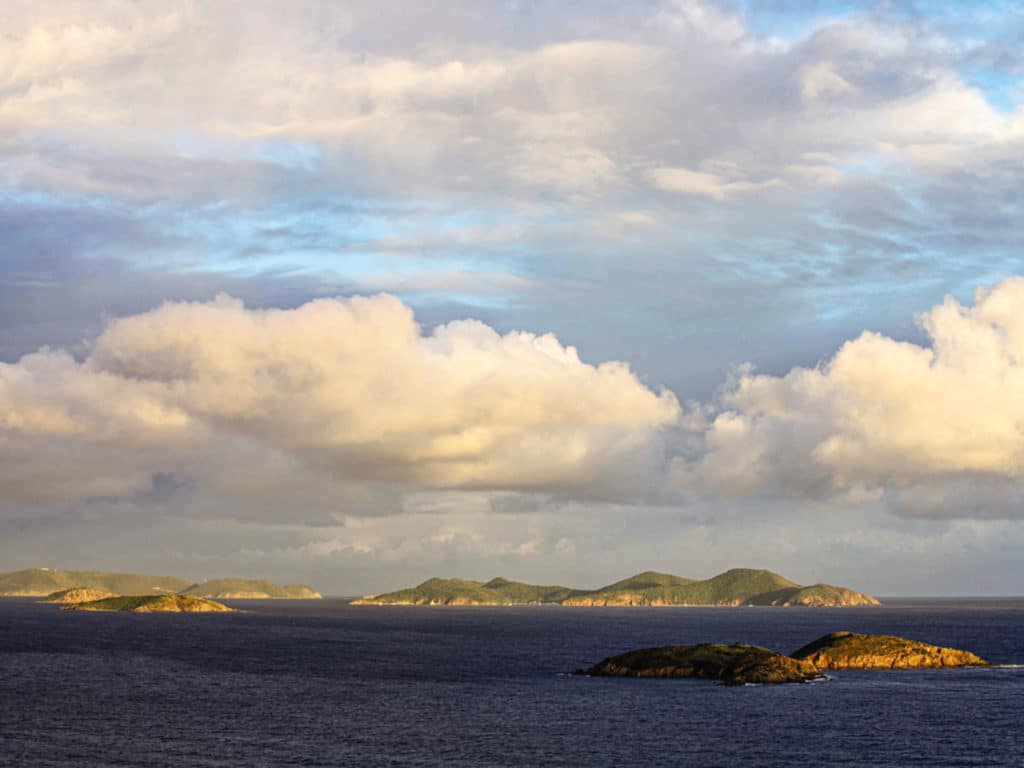
I was gloating about winning the first and probably only Flamingo Cup when a small crew of us gathered for Captain’s Hour aboard Luna, a ridiculously handsome Spirit 47 in Frederiksted, St. Croix. An impromptu race of four boats, all spending the season in the US Virgin Islands, had set off earlier from Christmas Cove, St. Thomas, and headed 35 miles south to St. Croix. It was great sailing, a classic Caribbean reach with lively trade winds and well-mannered loping seas. We often topped 10 knots. As the setting sun exploded into fiery twilight, we all agreed that the sail from St. Thomas to St. Croix is one of the best in the Caribbean.
While it was possible to sail to other Eastern Caribbean islands this past winter, the pandemic protocols of testing and quarantines made it complicated. Like many other cruisers, Tadji and I took the opportunity to rediscover the USVI. It was a reunion of sorts for me—St. Thomas was my first Caribbean landfall back in 1980. In those days, St. Thomas was the center of Caribbean sailing and of the chartering industry, and the sprawling natural harbor draping Charlotte Amalie was a forest of masts. Gradually the British Virgin Islands wrestled the charter business away from the USVI. The BVI concentrated on bareboats instead of crewed yachts, and mooring balls eliminated the stress of anchoring. Most importantly, they perfected the beach bar.
Today, the USVI is back as a sailing and charter destination
—and for good reason. The islands are geographically beautiful and abound with anchorages, mooring fields, marinas, and friendly residents. There’s no place in the Caribbean better for provisioning, chandleries are well-stocked, and boatyards can tackle most repairs and refits. And yes, there are plenty of beach bars. The resurgence has been partly fueled by the fact that the USVI has been on top of the pandemic from the start. It was an oasis for cruising sailors and remained open while many other islands shut down. It continues to find ways to accommodate cruisers. It requires a negative test within five days of departure from your last port, and there is easy access to testing throughout the islands when you arrive. Tadji and I were vaccinated in St. Croix this past spring.
The USVI consists of three main islands—St. Thomas, St. John and St. Croix—and countless other small islands and spits. Christmas Cove, in the lee of St. James Island, was our most frequent anchorage. It’s swept by a cool current with nice swimming and snorkeling, and dinghy access to St. Thomas. While St. Thomas is bustling ashore, the island has several uncrowded and protected anchorages. We spent a blustery New Year’s Eve, with winds gusting to 35 knots, anchored in Brewer’s Bay near the airport. Magens Bay on the north shore is lovely, and the beach is always voted one of the best in the world.
Even devotees of the BVI admit that St. John is the most beautiful of all the Virgin Islands. Two-thirds of the island is a national park. The park service maintains moorings around the island and has cleared miles of hiking trails ashore. We often picked up a mooring in Caneel Bay, and after a morning swim, walked over a lush hill to the quaint village of Cruz Bay. St. Croix to the south is the largest and least-visited island in the USVI, at least by sailors, but that’s changing. We made the lively sail to St. Croix, departing from St. Thomas and St. John, several times. The approach to Christiansted Harbor is well-marked, but the anchorage can be a bit rolly. Christiansted is the boyhood home of Alexander Hamilton. It’s one of the most beautiful towns in the Caribbean and was the former capital of the Danish West Indies. We often tarried at Frederiksted on the western edge, anchoring near the old cruise-ship dock. The pilings are draped in healthy coral, and sea turtles nonchalantly join you for every swim. It’s not a bad place to savor a win over your fellow cruisers either, even if our trophy was a pink inflatable flamingo.








